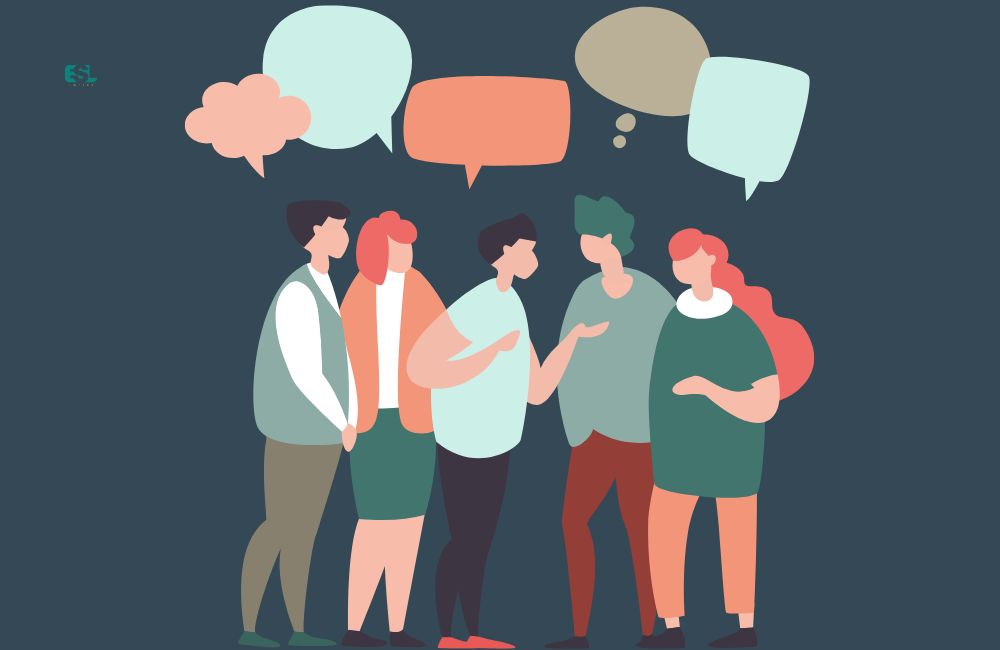Dealing with interruptions while you talk can be challenging, especially if you are a non-native English speaker. If you don’t know how to respond to interruptions politely and properly, the other person may get offended, or you may lose focus as a result of interruptions. Worry not! I’m here to provide a helpful guide to understanding and handling these disruptions smoothly and respectfully.
In English, dealing with conversational interruptions requires tact and courtesy. Strategies include maintaining composure, employing body language cues, asserting oneself politely, and acknowledging or incorporating valid interruptions.
Are you looking for a book or a guide to help you learn and improve your English? You may try English Made Easy Volume One: A New ESL Approach: Learning English Through Pictures (Amazon Link).
The ability to handle interruptions effectively is a vital communication skill. While the strategies outlined above offer a brief overview, there’s much more to learn about managing conversation interruptions. Keep reading for a more detailed exploration of types of interruptions, more strategies to handle them, and real-life examples to guide you in honing this important skill.
Table of Contents
- What Is Conversational Interruption?
- How to Deal with Conversational Interruptions
- Navigating Cooperative Interruptions Effectively
- Conversational Etiquette: The Foundation of Respectful Communication
- Bringing it All Together: Example Scenarios & Solutions
- Sample Conversation: Dealing with Conversational Interruptions in English
- Final Thoughts
- 10 Frequently Asked Questions Related to Dealing with Conversational Interruptions in English
What Is Conversational Interruption?
In any conversation, there’s a delicate balance to maintain. When this balance is upset by interruptions, it can cause feelings of frustration and discord. Understanding the nature and types of interruptions can help in managing them effectively.
In English conversation, as in many languages, interruptions are a common occurrence. They can sometimes be a source of miscommunication or conflict, especially when the intent behind the interruption isn’t fully understood.
Interruptions in a conversation are essentially instances where one person breaks into the speech of another person, often causing the original speaker to stop talking. They can happen for various reasons, and not all interruptions are necessarily negative.
In fact, depending on the context and the intent behind the interruption, they can be classified into two main categories: cooperative interruptions and disruptive interruptions.
Cooperative Interruptions
Cooperative interruptions are those that serve to enhance the conversation rather than halt it. These interruptions often occur when the listener is actively engaged in the conversation, and the interruption acts as a sign of their interest and involvement.
Cooperative interruptions, also known as ‘supportive interjections,’ occur when the person who interrupts adds value to the conversation. They may agree with the speaker, provide an additional point, or ask a relevant question. These interruptions are often seen as a sign of active listening and engagement.
Let’s consider a scenario where you’re explaining your idea for a new project to a team member. If they interrupt you with something like, “That’s an excellent point! Have you also considered adding this feature…?” – this is a cooperative interruption. They’re actively involved in your idea and contribute to it.
Disruptive Interruptions
In contrast to cooperative interruptions, disruptive interruptions tend to derail the conversation. They can often come off as rude or disrespectful, causing potential misunderstanding or conflict in the conversation.
Disruptive interruptions occur when the interrupter takes over the conversation, often without adding any value to the ongoing discussion. This could involve starting a new topic entirely or speaking over the original speaker without letting them finish their point. Disruptive interruptions can break the flow of conversation and potentially cause frustration.
For instance, imagine you’re in the middle of explaining your weekend trip to your friends, and one of them interrupts to talk about their dog’s new trick. This change of topic disrupts the flow of the conversation and might make you feel like your story isn’t valued. Such an interruption can be considered disruptive.
By understanding the different types of interruptions and the impact they have on a conversation, you can develop better strategies for managing interruptions when they occur and ensure that your conversations are effective and respectful.
How to Deal with Conversational Interruptions
Conversations are like intricate dance, with each participant taking turns to lead and follow. However, when someone abruptly interrupts, it can throw off the rhythm and balance of the dance. Dealing with such conversational interruptions can often be challenging, especially if you’re still gaining proficiency in the English language.
Nevertheless, with the right strategies and expressions at your disposal, you can manage these interruptions effectively and steer the conversation back on course. Let’s delve into some strategies that can help you regain control of your conversation when faced with interruptions.
1. Stay Calm
Maintaining your calm when interrupted is an essential first step to effectively managing such situations. Interruptions can sometimes feel like a personal affront, but it’s crucial to remember that they are often a common part of conversational dynamics.
The key is not to take it personally and avoid reacting impulsively. Keeping your emotions in check can prevent the conversation from spiraling into an argument and maintain a congenial atmosphere.
Here are a few phrases you can employ to help maintain your calm and signal to the interrupter that you would like to finish speaking:
- Let me finish my point.
- I’d like to wrap up my thoughts.
- Could I complete what I was saying?
- I just need a moment to finish.
- It’s important that I get to the end of this.
2. Use Body Language
Your body language is a powerful tool in conveying your intent to continue speaking. When interrupted, maintain eye contact with the person you spoke to before the interruption. This non-verbal cue signifies your interest in the conversation and your intention to continue.
Another effective method is slightly raising your hand or holding your palm towards the interrupter. This universally recognized sign acts as a polite ‘stop’ signal, indicating that you’re not yet finished speaking.
Here’s a list of body language cues that can be effectively used during a conversation to indicate that you are not finished speaking:
- Maintain eye contact with the listener.
- Slightly raise your hand.
- Keep an open body posture.
- Nod your head to indicate you acknowledge the interrupter but wish to continue.
- Use facial expressions to convey your desire to finish your point.
3. Assert Yourself Politely
If body language doesn’t suffice, it’s time to verbally assert your desire to complete your thoughts. The key is to be assertive without being aggressive or confrontational. Respectfully expressing your need to finish your point demonstrates your confidence and fosters mutual respect in the conversation. Here is a comprehensive list of expressions that can be used to politely assert yourself in a conversation:
- Please let me finish.
- I wasn’t quite finished.
- Could you let me finish my thoughts?
- May I complete my point?
- If you don’t mind, I’d like to finish.
- Excuse me, I still have something to say.
- I’d appreciate it if I could finish my point.
- Allow me to conclude my thoughts.
- Can I finish my thought before we move on?
- I need a moment more to finish.
- Could you hold your thought until I’m done?
- Just a moment, I’d like to wrap up what I was saying.
- I think it’s important for me to finish this.
- Excuse me, I’d like to finish my point.
- Can I just finish what I’m saying?
- Could I just conclude this point?
- Would you mind letting me finish?
- May I just complete what I was saying?
- Can I continue with my point?
- Could you let me finish my thought?
- I was in the middle of something. May I finish?
- Could you please hold on? I wasn’t finished.
- Do you mind if I finish my thought?
- I would like to finish my point, if I may.
- I’m not quite done; could you let me finish?
- I have a few more things to say about this.
- I’d like to finish my thought if that’s alright.
- If I could just get to the end of this.
- Please bear with me while I finish.
- I’m nearly done; could I just wrap up?
Navigating Cooperative Interruptions Effectively
When navigating the landscape of conversation, it’s crucial to remember that not all interruptions are disruptions. In fact, some can bring value and enrich the discussion. These are known as cooperative interruptions. They serve as a testament to the active participation and engagement of the listener and can enliven the conversation.
However, even though cooperative interruptions are generally positive, it’s still essential to know how to handle them effectively to ensure the conversation stays on track and everyone’s input is respected.
Embracing the Interruption: Acknowledgement as a Tool
Cooperative interruptions often stem from a place of enthusiasm and interest. They indicate that the interrupter is deeply engaged in the conversation and wants to contribute to it. In such situations, it’s essential to acknowledge their input. This validates their participation and ensures the conversation remains amicable and inclusive. Here is a list of phrases that can help you acknowledge a cooperative interruption:
- That’s a good point.
- I’m glad you brought that up.
- Your input is really insightful.
- I appreciate your perspective.
- That is an interesting thought; I was just about to touch on that.
- That’s an excellent addition to what I was saying.
- You make a valid point.
- I was thinking along the same lines.
- Your contribution gives a new dimension to the discussion.
- You’ve added value to what I was saying.
- That aligns with my thoughts.
- That’s an important point you’ve raised.
- Your idea complements what I was saying.
- You’ve given me a new way to look at it.
- That’s an intriguing perspective that ties in well with my point.
Weaving the Interruption into the Conversation
When the interruption adds to the discussion, it can be beneficial to incorporate it into your ongoing point. This approach acknowledges the interrupter’s contribution and maintains the conversation’s coherence and flow. Here’s how you can incorporate cooperative interruptions.
- Seamlessly blend the interrupter’s point with your own: Use phrases like “Adding to your point…” or “Building on what you said…”
- Use the interruption as a springboard for your next point: Start by saying, “Your point about X leads perfectly into…”
- Reflect on the interruption: Begin with, “That’s a thought-provoking point, and it makes me think about…”
- Relate the interruption back to your original point: Say something like, “This ties back to what I was saying earlier about…”
By managing cooperative interruptions effectively, you can create an engaging and dynamic conversation that values each participant’s contributions. Remember, the goal of any conversation is mutual understanding and the sharing of ideas, and cooperative interruptions can greatly enhance this process.
Conversational Etiquette: The Foundation of Respectful Communication
Managing interruptions and preventing becoming an interrupter yourself is essential when engaging in a conversation. Practicing good conversational etiquette can enhance the quality of your interactions and foster a respectful and collaborative environment for everyone involved. It entails respecting the speaker’s turn, exercising patience, and ensuring active and engaged listening. Here’s how you can uphold the principles of good communication etiquette.
The Art of Listening: Active Engagement
Active listening is a fundamental aspect of respectful conversation. It means fully focusing on the speaker and what they’re saying rather than merely waiting for your turn to speak or formulating your own response while they’re talking.
By being an active listener, you show respect for the speaker and their ideas and decrease the chances of unintentional interruptions. Here are some phrases that can be used to show you’re actively listening.
- I see what you’re saying.
- That’s an interesting point.
- Could you elaborate on that?
- I’d like to understand more about…
- That’s a compelling idea.
- I hadn’t considered that perspective before.
- Could you explain that further?
- It sounds like you’re saying…
- Your point about… is quite fascinating.
- I’m intrigued by what you just said about…
Respectful Interruptions: Asking for Permission
If you feel the need to interject in a conversation, it’s courteous to ask for permission first. This approach shows respect for the current speaker and allows for a smoother transition in the conversation, thereby reducing the abruptness associated with interruptions. Here are some respectful expressions to use when you wish to contribute to the conversation.
- May I add something here?
- Can I share my thoughts on this?
- If I could interject for a moment…
- Could I offer a different perspective?
- Would it be alright if I shared my viewpoint?
- Do you mind if I jump in here?
- Can I comment on that?
- Could I weigh in on this issue?
- May I express my take on this?
- Would you mind if I chimed in?
Exercising Patience: Wait Your Turn
Being patient and waiting for the speaker to finish their point before adding your thoughts is a crucial aspect of good communication etiquette. Not only does it demonstrate respect for the speaker’s ideas, but it also helps maintain the natural flow of the conversation, preventing it from turning into a chaotic back-and-forth of interruptions. These expressions show that you’ve been waiting patiently and now would like to contribute to the conversation:
- Now that you’ve finished, I’d like to add…
- I’ve been eager to mention…
- I’ve been waiting to say…
- I wanted to let you finish before bringing up…
- Now that there’s a break, I would like to say…
By upholding good communication etiquette, you can contribute to a more respectful, engaging, and productive conversational environment, ensuring everyone’s ideas are heard and valued.
Bringing it All Together: Example Scenarios & Solutions
In theory, understanding how to handle interruptions is essential, but applying this knowledge in real-life situations is where the true skill lies. To solidify the concepts discussed, let’s delve into some examples of different types of interruptions and discuss potential strategies for dealing with them.
Navigating Disruptive Interruptions: A Real-life Scenario
Let’s consider a common occurrence in professional settings:
Scenario: Imagine you’re in the middle of a team meeting, presenting a new project proposal. You’ve meticulously prepared for this presentation and are carefully explaining the project’s key components. Suddenly, a colleague interrupts you to talk about an unrelated topic. This interruption is disruptive because it breaks the flow of your presentation and diverts the attention of the team to a different issue.
Solution: To manage this interruption, the first step is to stay calm and composed. Getting flustered will only disrupt your presentation further. Next, use non-verbal cues to communicate your intention to continue speaking: maintain eye contact with the person you were addressing before the interruption and perhaps raise your hand slightly as a non-verbal sign that you wish to finish your point.
If these non-verbal cues aren’t enough, assert yourself politely. You could say, “I appreciate your enthusiasm for that topic, but may we discuss it after I’ve finished presenting my proposal?” This sentence not only respectfully asserts your right to finish speaking but also acknowledges the interrupter’s enthusiasm, ensuring the conversation remains respectful and productive.
Embracing Cooperative Interruptions: A Real-life Scenario
Cooperative interruptions are generally more common in informal settings, such as a conversation between friends:
Scenario: You’re telling a friend about an exciting weekend trip to a new city. You’re in the middle of describing the beautiful architecture you saw when your friend interrupts to share a similar experience they had on a recent trip of their own.
Solution: This is a cooperative interruption because your friend’s interruption adds value to the conversation and demonstrates their engagement with your story. Instead of being irritated, acknowledge their input. You could say something like, “That sounds like an incredible experience! It’s similar to what happened to me when…” and then continue with your own story. This approach values your friend’s contribution and ensures the conversation continues smoothly and inclusively.
By employing these strategies, you can effectively manage different types of interruptions and maintain the flow and respectfulness of your conversations, whether they occur in professional or informal settings. Remember, conversation is an art, and mastering this art can greatly enhance your interpersonal relationships.
Sample Conversation: Dealing with Conversational Interruptions in English
Situation: During a team brainstorming session, Alex is sharing an idea when his colleague, Mike, interrupts him.
Alex: Based on our last quarter’s performance, I believe we should consider expanding our marketing efforts in the…
Mike: Oh, speaking of marketing, I read an article about how influencer marketing is the next big thing.
Alex: That’s an interesting point, Mike. I’d love to hear more about it. Could I finish my thought first, and then we can discuss influencer marketing?
Mike: Oh, I’m sorry for interrupting. Please go ahead.
Alex: No problem, thanks. As I was saying, expanding our marketing efforts in the Southeast region could benefit us. Now, Mike, could you share more about influencer marketing?
Final Thoughts
Learning to navigate interruptions in English conversation requires patience and practice. Remember to remain calm, communicate clearly, and practice good listening etiquette. Over time, handling interruptions will become a natural part of your conversational skillset, improving your confidence and capability in English communication.
10 Frequently Asked Questions Related to Dealing with Conversational Interruptions in English
1. Why is it essential to address conversational interruptions?
Addressing interruptions ensures everyone has an equal opportunity to share their thoughts and contributes to effective communication.
2. What’s a polite way to handle someone who frequently interrupts?
You can say, “I appreciate your enthusiasm, but could we let everyone finish their points before jumping in?“
3. How can I prevent being interrupted?
Maintain steady eye contact, use open body language, and speak confidently.
4. Is it okay to interrupt someone if they’re going off-topic?
Yes, but do so respectfully with phrases like, “Sorry for cutting in, but can we steer back to the main topic?”
5. What if the interruption is for a valid reason, like an emergency?
In such cases, apologize for the interruption, briefly explain the reason, and address it promptly.
6. How can I re-enter a conversation after being interrupted?
Once the interrupter finishes, you can say, “As I was mentioning earlier…” and continue your point.
7. Can I ask others to help ensure I don’t get interrupted?
Yes, having allies in group settings can help. They can interject with, “Let’s hear Alex out” or “I’d like to know what Alex was going to say.”
8. How should I act if I unintentionally interrupted someone?
Apologize briefly, e.g., “Sorry for interrupting,” and allow the person to continue.
9. Is it essential to address every interruption?
Not necessarily. Gauge the situation. If it’s a one-time occurrence or unintentional, it might be best to let it slide.
10. Can setting ground rules before a discussion help in minimizing interruptions?
Absolutely. Establishing discussion norms, like allowing everyone to finish their points, can lead to more structured and respectful conversations.






